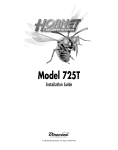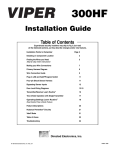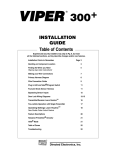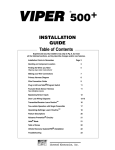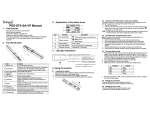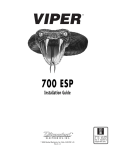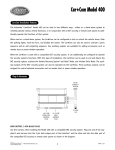Download Automate 410 Installation guide
Transcript
® Model 410 Installation Guide ® © 1999 Directed Electronics, Inc. Vista, CA N410A 10-99 table of contents What Is Included . . . . . . . . . . . . . . . . . . . . . 3 Installation Points To Remember . . . . . . . . . . 4 Wiring the Control Unit. . . . . . . . . . . . . . . . . 4 Primary Harness (H1), 12-pin Connector . . . . . 5 Primary Harness (H1) Wire Connection Guide. . 6 Plug-In LED and Valet/Program Switch . . . . . . 11 Harness 2 (H2), (+/-) Door Lock Outputs . . . 12 Door Lock Wiring Diagrams Type A Door Locks. . . . . Type B Door Locks. . . . . Type C Door Locks . . . . . Type D Door Locks. . . . . Type E Door Locks . . . . . Type F Door Locks . . . . . . . . . . . . . . . . . . . . . . . . . . . . . . . . . . . . . . . . . . . . . . . . . . . . . . . . . . . . . . . . . . . . . . . . . . . . . . . . . . . . . . . . . . . . . . . . 12 12 13 14 15 16 16 Transmitter Configurations. . . . . . . . . . . . . . 18 Standard Configuration. . . . . . . . . . . . . . . 18 OEM Style Configuration . . . . . . . . . . . . . . 19 Two Vehicle Operation With A Single Transmitter. . . . . . . . . . . . . . . . . . . . 19 Operating Settings Learn Routine . . . . . . . . . 20 To access another feature . . . . . . . . . . . . . 21 To exit the learn routine. . . . . . . . . . . . . . 21 Features Menu . . . . . . . . . . . . . . . . . . . . . . 21 Feature Descriptions . . . . . . . . . . . . . . . . . . 22 Rapid Resume Logic . . . . . . . . . . . . . . . . . . 23 Master Dealer Remotes . . . . . . . . . . . . . . . . 23 Troubleshooting . . . . . . . . . . . . . . . . . . . . . 24 Transmitter/Receiver Learn Routine. . . . . . . . 17 To advance from one channel to another . . . 18 To exit learn routine . . . . . . . . . . . . . . . . 18 Bitwriter™, Code Hopping™, DEI®, Doubleguard®, ESP™, FailSafe®, Ghost Switch™, Learn Routine™, NiteLite®, Nuisance Prevention Circuitry®, NPC®, Revenger®, Silent Mode™, Soft Chirp®, Stinger®, Valet®, Vehicle Recovery System®, VRS®, and Warn Away® are all Trademarks or Registered Trademarks of Directed Electronics, Inc. 2 © 1999 Directed Electronics, Inc. Vista, CA what is included ■ ■ ■ ■ The control module (see diagram) Two 476A remote transmitters The plug-in status LED The plug-in Valet®/Program switch Primary Harness (H1) Pre-wired Failsafe® Starter Kill Relay 3-pin Data/Program Plug H2 Door Lock Harness Port Plug-in LED port © 1999 Directed Electronics, Inc. Vista, CA Blue Valet®/Program switch plug 3 installation points to remember This system has been designed to provide the ultimate in convenience to both the dealer and the end user. The microprocessor at the heart of the system utilizes a sophisticated “Learn Routine” to program transmitters as well as configure operation settings. Transmitter codes and operations settings are stored in “EEPROM” and will remain in memory even if the system’s main power is disconnected for extended periods of time. Please take the time to read this guide thoroughly prior to installing the system. Do not disconnect the battery if the vehicle has an anti-theft coded radio. If equipped with an airbag, avoid disconnecting the battery if possible. IMPORTANT! Many airbag systems will display a diagnostic code through their warning light after they lose power. Disconnecting the battery requires this code to be erased, a procedure that can require a trip to the dealer. Before beginning the installation: ■ Check with the customer on status LED location. ■ Remove the domelight fuse. This prevents accidentally draining the battery. ■ Roll down a window to avoid being locked out of the car. After the installation: ■ Test all functions. The “Using Your System” section of the Owner’s Guide is very helpful when testing. wiring the control unit The wiring harness supplied with this unit is the standard 12 pin harness used by DEI security systems. Two wires in the plug are not used. The functions of all the wires that are used in the primary harness are outlined in the following Primary Harness (H1), 12-Pin Connector section. The wire connections are described in the Primary Harness (H1) Wire Connection Guide section. 4 © 1999 Directed Electronics, Inc. Vista, CA primary harness (H1), 12-pin connector H1/1 H1/2 H1/3 H1/4 H1/5 H1/6 H1/7 H1/8 ______ ______ ______ ______ ______ ______ ______ ______ ORANGE WHITE WHITE/BLUE BLACK/WHITE GREEN BLUE (-) 500 mA GROUND-WHEN-ARMED OUTPUT (-) PARKING LIGHT OUTPUT (-) 200 mA CHANNEL 3 VALIDITY OUTPUT (-) 200 mA DOMELIGHT SUPERVISION OUTPUT NO FUNCTION (-) 200 mA SECOND UNLOCK OUTPUT VIOLET NO FUNCTION BLACK (-) CHASSIS GROUND INPUT H1/9 ______ YELLOW (+) SWITCHED IGNITION INPUT H1/10 ______ BROWN (-) HORN HONK OUTPUT H1/11 ______ RED H1/12 ______ RED/WHITE © 1999 Directed Electronics, Inc. Vista, CA (+) CONSTANT POWER INPUT (-) 200 mA CHANNEL 2 VALIDITY OUTPUT 5 primary harness (H1) wire connection guide H1/1 ORANGE (-) ground-when-armed output This wire supplies a (-) 500 mA ground as long as the system is armed. This output ceases as soon as the system is disarmed. The orange wire is pre-wired to control the DEI® 8618 starter kill relay. NOTE: If connecting the orange wire to control another module, such as a DEI® 529T or 530T window controller, a 1 amp diode (type 1N4004) will be required. Insert the diode as shown in the diagram below. IMPORTANT! Never interrupt any wire other than the starter wire. H1/2 WHITE (-) parking light output This wire provides a (-) 200mA output to flash the parking lights. This is suitable for driving (-) light control wires in Toyota, Lexus, BMW, some Mitsubishi, some Mazda, etc. If the vehicle has a positive parking light circuit, a relay must be used to flash the parking lights. H1/3 WHITE/BLUE (-) channel 3 output This wire provides a (-) 200 mA output whenever the transmitter code controlling Channel 3 is received. This output will continue as long as that transmission is received. Use for options such as DEI’s 551T Valet® Start system, 529T or 530T power window controllers, etc. 6 © 1999 Directed Electronics, Inc. Vista, CA IMPORTANT! Never use this wire to drive anything but a relay or a low-current input! The transistorized output can only provide 200 mA of current, and connecting directly to a solenoid, motor, or other high-current device will cause it to fail. H1/4 BLACK/WHITE (-) 200 mA domelight supervision output Connect this wire to the optional domelight supervision relay as shown below: IMPORTANT! This output is only intended to drive a relay. It cannot be connected directly to the domelight circuit, as the output cannot support the current draw of one or more light bulbs. H1/6 BLUE (-) 200 mA second unlock output The H1/6 BLUE output is used for progressive unlock. A progressive unlock system unlocks the driver's door when the unlock (disarm) button is pressed and unlocks the passenger doors if the unlock (disarm) button is pressed again within 15 seconds after unlocking the driver's door. The BLUE wire outputs a low current (-) pulse on the second press of the unlock button of the transmitter. This negative unlock output is used to unlock the passenger doors. © 1999 Directed Electronics, Inc. Vista, CA 7 Type A (+) polarity system: Wire relays as shown. Type B (-) polarity system: Connect the BLUE H1/6 wire to the unlock wire in the vehicle and wire the relay as shown. 8 © 1999 Directed Electronics, Inc. Vista, CA Type C (+) reversing polarity system: Wire relays as shown. H1/8 BLACK (-) chassis ground connection Connect this wire to bare metal, preferably with a factory bolt rather than your own screw (screws tend to either strip or loosen with time). We recommend grounding all your components to the same point in the vehicle. © 1999 Directed Electronics, Inc. Vista, CA 9 H1/9 YELLOW (+) ignition input Connect this wire to an ignition source. This input must show (+)12V with the key in run position and during cranking. Make sure that this wire cannot be shorted to the chassis at any point. This wire will trigger the system if the ignition is turned on before the unit is disarmed (doors unlocked with the remote). It will also honk the vehicle’s horn and flash the parking lights (if connected). H1/10 BROWN (-) horn honk output This wire supplies a 200 mA (-) output that can be used to honk the vehicle horn. It outputs a single pulse when locking the doors with the remote, and two pulses when unlocking with the remote. This wire will also output pulses for 30 seconds when the Panic Mode is activated. If the vehicle has a (+) horn circuit, an outboard relay can be used to interface with the system, as shown below. H1/11 RED (+)12V constant power input Before connecting this wire, remove the supplied fuse. Connect to the positive battery terminal or the constant 12V supply to the ignition switch. NOTE: Always use a fuse within 12 inches of the point you obtain (+)12V power. Do not use the 10A fuse in the harness for this purpose. This fuse protects the module itself. 10 © 1999 Directed Electronics, Inc. Vista, CA H1/12 RED/WHITE channel 2, 200mA (-) output When the system receives the transmitter code controlling Channel 2 for longer than 1.5 seconds, the RED/WHITE wire will supply an output as long as the transmission continues. This is often used to operate a trunk/hatch release or other relay-driven functions. IMPORTANT! Never use this wire to drive anything but a relay or a low-current input! The transistorized output can only supply 200 mA of current. Connecting directly to a solenoid, motor, or other high-current device will cause it to fail. plug-in LED and valet/program switch The LED and the Valet/Program switch both plug into the control module. The status LED plugs into the small two-pin port, while the Valet®/Program switch should be plugged into the larger blue two-pin port. The status LED and Valet®/Program switch each fit into 9/32-inch holes. Status LED © 1999 Directed Electronics, Inc. Vista, CA Valet®/Program Switch 11 harness 2 (H2), (+/-) door lock outputs H2/A H2/B H2/C ______ ______ ______ GREEN (-) LOCK, (+) UNLOCK OUTPUT EMPTY UNLESS USING 451M BLUE (-) UNLOCK, (+) LOCK OUTPUT door lock wiring diagrams This system can control two common power door lock types without any additional parts! To interface with some vehicles or if an actuator is to be installed, you will need a 451M Door Lock Relay Satellite or two relays. type A: (+) 12V pulses from the switch to the factory relays This security system can control Type A door locks directly, with no additional parts. The switch will have three wires on it, and one will test (+)12V constantly. The others will alternately pulse (+)12V when the switch is pressed to the lock or unlock position. If you cannot get to the switch, and you find a set of wires that pulse (+)12V alternately on lock and unlock, you must take care to ensure that it is not a Type C direct-wire system. IMPORTANT! If you mistake a Type C direct-wired system for a Type A positive-pulse system, the module will be damaged! Here is a test: Cut the wire which pulses (+)12V on lock, and then operate the switch to unlock. ■ If all doors unlock, the vehicle uses a Type A system. ■ If you lose all door lock operation in both directions, you are operating the master switch in a Type C system. ■ If one or more, but not all, motors stop operating, you have cut a wire leading directly to one or more motors. Reconnect the wire and look for another wire. Many domestically-made GM vehicles use Type A locks. However, many more GM vehicles are Type C than in previous years. The full-size pickups (1989-later), many of the S10 Blazers, the Corvette, '95 Cavalier/Sunfire 1993 and newer, Camaro/Firebird all use Type C door locks, and cannot be controlled without a 451M! Almost all domestically-built Fords are Type C. Ford builds almost no Type A systems. Chrysler builds both Type A and Type C, so test carefully. 12 © 1999 Directed Electronics, Inc. Vista, CA IMPORTANT! Remember that the functions of these wires reverse between Type A and Type B! type B: (-) pulses from the switch to the factory relays This system is common in many Toyotas, Nissans, Hondas and Saturns, as well as Fords with the keyless-entry systems (some other Fords also use Type B). The switch will have three wires on it, and one wire will test ground all the time. One wire will pulse (-) when the switch locks the doors, and the other wire will pulse (-) when the switch unlocks the doors. This type of system is difficult to mistake for any other type. IMPORTANT! Remember that the functions of these wires reverse between Type A and Type B! © 1999 Directed Electronics, Inc. Vista, CA 13 type C: reversing polarity Interfacing with a reversing polarity system requires either two relays or one 451M (not included). It is critical to identify the proper wires and locate the master switch to interface properly. Locate wires that show voltage on lock and unlock. Cut one of the suspect wires and check operation of the locks from both switches. If one switch loses operation in both directions and the other switch operates in one direction only, you have located one of the target wires. The switch that lost all operation is the master switch. If one switch works both directions and the other switch works only one direction, you have a Type A system. If both switches still operate, but one or more doors have stopped responding entirely, you have cut a motor lead. Reconnect it and continue to test for another wire. Once both wires have been located and the master switch identified, cut both wires and interface as shown below. IMPORTANT! If these are not connected properly, you will send (+) 12 Volts directly to (-) ground, possibly damaging the factory switch. 14 © 1999 Directed Electronics, Inc. Vista, CA type D: after-market actuators In order for this system to control one or more aftermarket actuators, a 451M or two relays (optional) are needed. Vehicles without factory power door locks require the installation of one actuator per door. This requires mounting the door lock actuator inside the door. Other vehicles may only require one actuator installed in the driver's door if all door locks are operated when the driver's lock is used. This type of installation is required to operate factory lock systems in Volvo (except 850), SAAB, and most Mazda, Isuzu and Subaru models. The fuse used on 12V inputs should be 7.5A per motor installed in the vehicle. IMPORTANT! Do not connect the outputs of the alarm directly to the actuator! © 1999 Directed Electronics, Inc. Vista, CA 15 type E: mercedes-benz and audi (1985 & newer) Door locks are controlled by an electrically activated vacuum pump. Some Mercedes and Audis use a Type D system. Test by locking doors from the passenger key cylinder. If all the doors lock, the vehicle's door lock system can be controlled with just two relays (optional). The control wire can be found in either kick panel and will show (+)12V when doors are unlocked and (-) ground when doors are locked. To interface see diagram below. The system must be programmed for 3.5 second door lock pulses (see Operating Settings Learn Routine section of this guide). type F: one-wire system Type F door locks usually require a negative pulse to unlock, and cutting of the same wire to lock the door. In some vehicles, these are reversed. Type F door locks are found in some late-model Nissan Sentras, 240SX, and 1992 and later Nissan 300ZX. They are also found in some Mazda MPV's and some Mitsubishi's. One relay (optional) is used to interface Type F door locks as follows: 16 © 1999 Directed Electronics, Inc. Vista, CA ™ transmitter/receiver learn routine Transmitters are taught to the system using the Learn Routine. This system will learn up to four transmitters. Both transmitters come factory programmed using the Standard OEM Style Transmitter Configuration described in the Transmitter Configurations section. This configuration can be changed or new remotes can be added to the system using the Learn Routine. For added security, this Learn Routine can be locked using the DEI Bitwriter (P/N 998T). If the unit does not respond to the Learn Routine, plug the Bitwriter into the data port of this unit and verify that the Transmitter Programming is UNLOCKED. 1. Key. Turn the ignition to the run position. (The YELLOW H1/9 wire must be already be connected.) 2. Valet®/Program switch. Press and release the Valet®/Program switch the correct number of times corresponding to the desired channel number. Then press the Valet/Program switch once more and HOLD it. The LED will blink to indicate the selected channel and the horn will honk (if connected). Do not release the Valet/Program switch. CHANNEL NUMBER PRESS AND RELEASE THE VALET/PROGRAM SWITCH TO PROGRAM FUNCTION 1 One time Lock/Arm, Unlock/Disarm, Panic 2 Two times Channel 2 output 3 Three times Channel 3 output 4 Four times Lock/Arm, Panic 5 Five times Unlock/Disarm, Channel 2 6 Six times Panic only 7 Seven times Auto Learn Standard Configuration* 8 Eight times Auto Learn Single Button Arm/Disarm Configuration* 9 Nine times Delete all transmitters * NOTE: For Auto Learn Configurations, see Transmitter Configurations section of this guide. NOTE: Channel Nine of the Transmitter Learn Routine will delete all transmitters that are programmed into the system as well as change the operating settings back to the default settings (see Operating Settings Learn Routine section of this guide). To use this option, select Channel 9 (LED will blink nine times) then transmit from any button of a known transmitter. 3. Transmit. While holding the Valet®/Program switch, press the button on the transmitter that you would like to control the selected receiver channel. One honk will confirm that the code has been learned. 4. Release. Once the code is learned, the Valet/Program switch can be released. © 1999 Directed Electronics, Inc. Vista, CA 17 to advance from one channel to another You can advance from one channel to another by releasing the Valet®/Program switch and tapping it to advance channels and then holding it. For instance: You have programmed Channel 1 and you want to program Channel 2. Release the Valet®/Program switch. Press it one time and release it to advance from Channel 1 to Channel 2. Now, press and hold the Valet/Program switch down and the unit will chirp twice. As before, do not release it. If you want to program Channel 3 after programming Channel 1, release the Valet/Program switch, press it twice and then release it to advance to Channel 3. Then press the Valet/Program switch once more and hold it. The horn will honk three times to confirm it is ready to receive the code from the transmitter to program Channel 3. to exit learn routine The learn routine will be exited if: ■ The ignition is turned off. ■ The Valet/Program switch is pressed too many times. ■ More than 15 seconds elapses between steps. One long horn honk (if connected) indicates that the Learn Routine has been exited. transmitter configurations The transmitters can be programmed with the Standard Configuration or Single Button Arm/Disarm Configuration by using the Auto Learn functions in the Transmitter/Receiver Learn Routine. standard configuration A remote that uses the Standard (OEM Style) Configuration operates similarly to many factory keyless entry remotes. A Standard Configuration transmitter allows door lock/arm, door unlock/disarm, and Panic Mode activation with separate buttons. When programmed for Standard OEM Style Configuration, the transmitter buttons are assigned to the following functions: . . . . . . . . . operates . . . . . . . . . . Lock/Arm . . . . . . . . . operates . . . . . . . . . . Unlock/Disarm . . . . . . . . . operates . . . . . . . . . . Channel 2 . . . . . . . . . operates . . . . . . . . . . Panic and 18 operate . . . . . . . . . . Channel 3 © 1999 Directed Electronics, Inc. Vista, CA single button arm/disarm configuration When programmed for single button arm/disarm configuration, the transmitter buttons are assigned as follows: . . . . . . . . . operates . . . . . . . . . . Lock/Arm, Unlock/Disarm, and Panic . . . . . . . . . operates . . . . . . . . . . Channel 2 . . . . . . . . . operates . . . . . . . . . . Channel 3 two vehicle operation with single transmitter You can get two-vehicle operation with the transmitters that come with this system. Using the 476A transmitters, all auxiliary channels are available on both vehicles. Before programming, make a list of all channels on each vehicle, and decide which button(s) should control which channel. For example, if you wanted the top two buttons to control Vehicle One and the bottom two buttons to control Vehicle Two, here is how each system would be programmed: Vehicle One . . . . . . . . . operates . . . . . . . . . . Lock/Arm, Unlock/Disarm, Panic . . . . . . . . . operate . . . . . . . . . . Channel Two and operate . . . . . . . . . . Channel Three Vehicle Two . . . . . . . . . operates . . . . . . . . . . Lock/Arm, Unlock/Disarm, Panic . . . . . . . . . operates . . . . . . . . . . Channel Two and © 1999 Directed Electronics, Inc. Vista, CA operate . . . . . . . . . . Channel Three 19 ™ operating settings learn routine Many of the operating settings of this unit are programmable. They can be changed whenever necessary through a computer-based learn routine. To simplify programming, the DEI Bitwriter (P/N 998T) can be used to change options as well as lock the Learn Routine. If there is no response from the Learn Routine, plug the DEI Bitwriter into the data port and verify that the Feature Programming is unlocked. 1. Key. Turn the ignition on and then back off. (The H1/9 YELLOW switched ignition input must be connected.) 2. Choose. Within 10 seconds, press and release the Valet®/Program switch the number of times corresponding to the feature number you want to program (see the Features Menu section of this guide). The LED ON settings listed in the Features Menu table are the factory default settings. Once the Valet/Program switch has been pressed and released the number of times corresponding to the feature you wish to program, press it once more and hold it. After a second, the LED will flash to indicate which feature you have accessed. For example, groups of five flashes would indicate access to Feature 5 (Active/Passive Locking feature). The horn will also honk five times (if connected). 3. Transmit. The transmitter is used to select the desired setting. As shipped, the unit is configured to the default LED ON settings. Pressing the lock/arm button will set the feature to the LED ON setting. The LED will light solid (stop flashing) to indicate the setting. The horn will honk once (if connected). Pressing the unlock/disarm button (on a Standard OEM Style Configuration transmitter) will change the setting to the LED OFF setting. The LED will turn off indicating the change and the horn will honk twice (if connected). 4. Release. The Valet®/Program switch can now be released. For example, to program Feature 1 (Arming Mode) from active to passive, within 10 seconds of turning the ignition off, press and release the Valet®/Program switch once. Then press it again and hold it. The LED will flash in groups of one and the horn will honk once (if connected). While holding the Valet®/Program switch, press the unlock/disarm button (on a Standard OEM Style Configuration transmitter). The LED will stop flashing and go out. The horn will honk twice if connected. Passive arming is now programmed. If that was not the desired setting, without releasing the Valet®/Program switch, press the lock/arm button on the transmitter. The LED will light solid and the horn will honk once if connected. Active arming is now programmed. Release the Valet®/Program button after the correct selection is made. 20 © 1999 Directed Electronics, Inc. Vista, CA to access another feature You can advance from feature to feature by pressing and releasing the Valet®/Program switch the number of times necessary to get from the feature you just programmed to the feature you wish to access. For example, if you just programmed Feature 1 for passive arming and you want to program Feature 2 (Arm/Disarm Confirmation Honks): 1. Release the Valet®/Program switch. 2. Press and release the Valet/Program switch once to advance from Feature 1 to Feature 2. 3. Press the Valet®/Program switch once more and hold it. 4. The LED will flash in groups of two and the horn will honk twice (if connected) to confirm that you have accessed Feature 2. to exit the learn routine The learn routine will be exited if: ■ The ignition is turned on. ■ The Valet®/Program switch is pressed too many times. ■ More than 15 seconds elapses between steps. One long horn honk (if connected) indicates that the Learn Routine has been exited. features menu FEATURE NUMBER DEFAULT LED ON SETTINGS LED OFF SETTINGS (PRESS CHANNEL 1 TRANSMITTER BUTTON) (PRESS CHANNEL 2 TRANSMITTER BUTTON) 1 Active arming Passive arming 2 Arm/disarm confirmation honks ON Arm/disarm confirmation honks OFF 3 Ignition-controlled door lock ON Ignition-controlled door lock OFF 4 Ignition-controlled door unlock ON Ignition-controlled door unlock OFF 5 Active locking Passive locking 6 Ignition-controlled domelight ON Ignition-controlled domelight OFF 7 0.8 second door lock pulses 3.5 second door lock pulses 8 Double pulse unlock OFF Double pulse unlock ON 9 Security features ON Security features OFF 10 Code Hopping ON Code Hopping OFF © 1999 Directed Electronics, Inc. Vista, CA 21 feature descriptions 1 ACTIVE/PASSIVE ARMING: When active arming is selected, the system will only arm when the transmitter is used. When set to passive, the system will arm automatically 30 seconds after the ignition is turned off. Passive arming is indicated by the rapid flashing of the LED. 2 ARM/DISARM CONFIRMATION HONKS ON/OFF: This feature controls the horn honks that confirm the arming and disarming of the system. 3 IGNITION CONTROLLED DOOR LOCK ON/OFF: When turned on, the doors will lock three seconds after the ignition is turned on. 4 IGNITION CONTROLLED DOOR UNLOCK ON/OFF: When turned off, the doors will unlock when the ignition is turned off. 5 ACTIVE/PASSIVE LOCKING: If passive arming is selected in Feature 1, then the system can be programmed to either lock the doors when passive arming occurs, or only lock the doors when the system is armed via the transmitter. Active locking means the system will not lock the doors when it passively arms. Passive locking means that the system will lock the doors when it passively arms. 6 IGNITION CONTROLLED DOMELIGHT: If turned on, the system will turn on the domelight for 30 seconds when the ignition is turned off. The domelight supervision output (H1/4) wire must be connected to an optional relay as described in the Primary Harness Wire Connection Guide. 7 DOOR LOCK PULSE DURATION: Some European vehicles, such as Mercedes-Benz and Audi, require longer lock and unlock pulses to operate the vacuum pump. Programming the system to provide 3.5 second pulses will accommodate door lock interface in these vehicles. The default setting is 0.8 second door lock pulses. See "Mercedes-Benz and Audi - 1985 and Newer (Type E Door Locks section)" diagram. 8 DOUBLE PULSE UNLOCK OFF/ON: Some vehicles require two pulses on a single wire to unlock the doors. When the double pulse unlock feature is turned on, the BLUE H2/C wire will supply two negative pulses instead of a single pulse. At the same time, the GREEN H2/A wire will supply two (+) pulses instead of a single pulse. This makes it possible to directly interface with double pulse vehicles without any extra parts. 9 SECURITY FEATURES ON/OFF: In the ON setting the (-) ground-when-armed output will be active and can be used to operate starter kill. The unit will also trigger a panic sequence if the ignition is turned on before disarming the system. Turning the security features off will turn off both the starter kill feature and the triggered sequence with ignition. 10 CODE HOPPING™ ON/OFF: This system features Code Hopping™ as an option. To use Code Hopping™ technology, you must program this feature on. Code Hopping™ is a feature that uses a mathematical formula to change the system’s code each time the transmitter and receiver communicate. This makes the group of bits or "word" from the transmitter very long. The longer the word is, the easier it is to block its transmission to the unit. 22 © 1999 Directed Electronics, Inc. Vista, CA Disabling the Code Hopping™ feature lets the receiver ignore the Code Hopping™ part of the transmitted word. As a result, the unit may have better range with Code Hopping™ off. rapid resume logic This DEI system will store its current state to non-volatile memory. If power is lost and then reconnected the system will recall the stored state from memory. This means if the unit is in Valet Mode and the battery is disconnected for any reason, such as servicing the car, when the battery is reconnected the unit will still be in Valet Mode. This applies to all states of the system including arm, disarm, and Valet Mode. master dealer remotes A master dealer remote can be programmed into the system for demonstration purposes. Generally, each salesman would carry a remote that would operate all the cars on the lot equipped with this system. The dealer remotes are binary transmitters that are detuned slightly in order to limit transmitting range. The dealer remote can be taught to the system by following the Transmitter Learn Routine. When installing the system, it is possible to preset all of the operation settings using the master dealer remote. However, when the system is operated using the master dealer remote, a special set of dealer default settings are followed. The dealer default settings are used to ensure that every vehicle equipped with this system is protected at all times. Only the settings listed below are affected. When using a master dealer remote, the system operates as follows: ■ Passive arming ■ Confirmation honks on ■ Ignition lock and unlock on ■ Passive locking ■ Ignition domelight on ■ Security features on The dealer default settings only affect the settings listed above. The remaining features control outputs of the system that must be programmed to meet the needs of the installation. Once the vehicle is delivered to the end user, two Code Hopping transmitters should be taught to the system. The system will then operate according to how the operating settings have been preset. It is also possible to reprogram the operating settings using a standard Code Hopping transmitter if necessary. When a Code Hopping™ transmitter is taught to the system, the master dealer remote is automatically erased from memory. © 1999 Directed Electronics, Inc. Vista, CA 23 troubleshooting Starter kill does not work: ■ Is the correct starter wire being interrupted? If the car starts when the starter kill relay is completely disconnected, the wrong starter wire has been cut and interrupted. ■ Is the yellow wire connected to “true” ignition? Make sure this wire is connected to a wire that has power in the run and start positions. The Valet® switch does not work. ■ Is it plugged into the correct socket? See Plug-In LED and Valet®/Program Switch section. Is the H1/9 YELLOW wire properly connected? See Primary Harness (H1) Wire Connection Guide section of this guide. Status LED does not work. ■ Is the LED plugged into the small white port on the side of the control unit? See Plug-In LED and Valet®/Program Switch section. Door locks operate backwards. ■ This unit has easily-reversed lock/unlock outputs. Recheck Harness 2, (+/-) Door Lock Outputs section to see if you have reversed these. The horn honks when the unit enters panic mode, but the confirmation honks do not work when locking and unlocking. ■ Are the confirmation honks turned on in programming? See Operating Settings Learn Routine and Feature Descriptions sections. I can get into programming and change the feature settings, but when I use the remote the settings seem to change. ■ Are you using a binary, master dealer remote? Remember, you can program the settings using a master dealer remote. However, the unit will follow the dealer default settings when using a binary remote to operate the system. 24 © 1999 Directed Electronics, Inc. Vista, CA


























